ICSE Class 10 Chemistry Specimen Paper 2024
Council for the Indian School Certificate Examinations (CISCE) has released the latest ICSE Class 10 Chemistry Specimen Paper 2024. All the ICSE Specimen Paper 2024 for class 10th are available on the CISCE’s official website, cisce.org.
The ICSE 10th exams 2024 will take place in pen and paper format. The exams are scheduled between February 21 and March 28, 2024. Science stream students need to be well prepared in Chemistry to get good marks in the final exam. Students are advised to download the ICSE Chemistry Specimen Paper 2024 PDF and practice it several times. They will be familiar with the ICSE exam pattern, chemistry syllabus and level other question papers by practicing this Chemistry specimen paper 2024.
Chemistry Specimen Paper 2024 ICSE – Highlights
The Council for the Indian School Certificate Examinations (CISCE) is a renowned national-level education board in India. ICSE is popular for its extensive curriculum, which emphasizes holistic development and prepares students for the challenges of higher education. Let’s take a look at the summary of the Chemistry Specimen paper 2024 ICSE.
| ICSE Specimen Paper 2024 – Highlights | |
| Subject | Chemistry |
| Paper Name | ICSE Class 10 Chemistry Specimen Paper 2024 |
| Board Name | India Certificate of Secondary Education |
| Class | Class 10 |
| Date of Release | Available to Download |
| Academic Session | 2023-24 |
| Exam Date | February / March 2024 |
| Official Website | cisce.org/specimen-question-papers-icse-class-x-2024-2 |
Download ICSE Chemistry Specimen Paper 2024 PDF
The ICSE board guarantees very high academic benchmarks and promotes a well-rounded education by emphasizing extracurricular activities and community service. They also publish the ICSE Chemistry Specimen paper 2024 PDF collection for all subjects to assist students in determining the level of the exam. Click on the link below to access the ICSE Chemistry class 10 Specimen paper 2024 pdf.
| ICSE Class 10 Chemistry Specimen Paper 2024 PDF |
| ICSE Class 10 Chemistry Specimen Paper 2024 PDF Download |
How to Download ICSE Chemistry Class 10 Specimen Paper 2024?
We have provided a link to download the ICSE Chemistry Class 10 Specimen Paper 2024 pdf. Students can, however, obtain the ICSE Chemistry Specimen Paper 2024 from the board’s official website. follow the steps outlined below.
Step 1: Go to cisce.org (the official website of ICSE).
Step 2: Three options will be displayed. From the drop-down menu, choose Examination.

Step 3: Choose the ICSE exam and scroll to the “Important Downloads” section.
Step 4: Go to the ICSE “Specimen Question Paper” page.
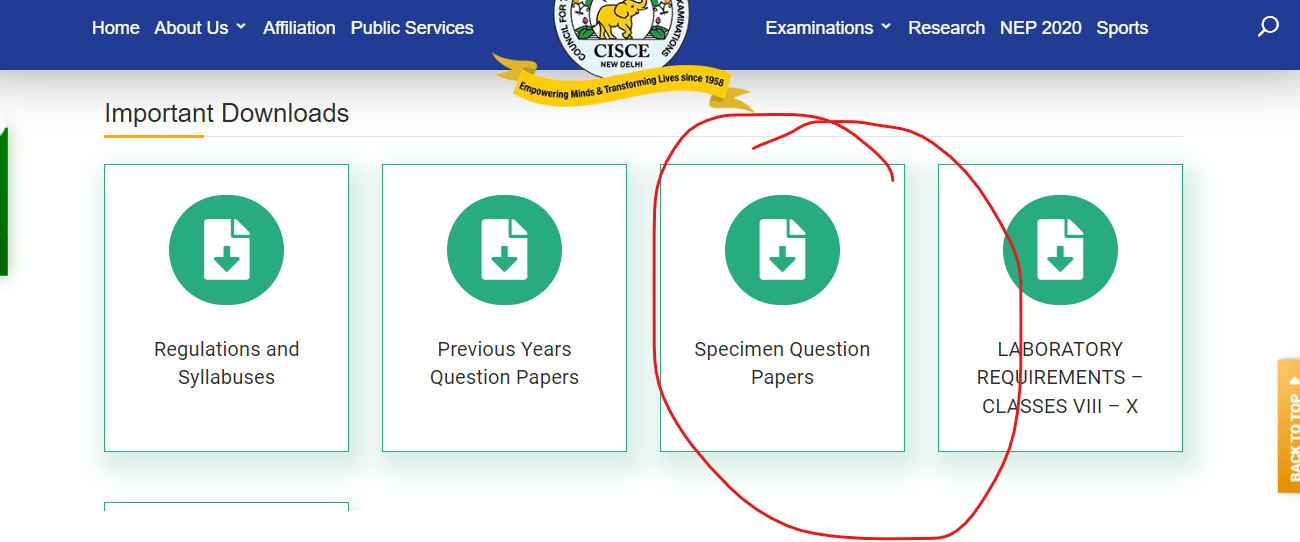
Step 5: A new page with a list of many years of specimen paper appears on the screen.
Step 6: Navigate to the page for the ICSE Specimen Paper 2024.
Step 7: The “Specimen Question Papers ICSE CLASS X – 2024” page will now appear.
Step 8: At this point, you can download your specimen paper by selecting chemistry.
Chemistry Specimen Paper 2024 – Instruction
We have mentioned some crucial instructions about Chemistry Specimen Paper 2024. These rules you should follow before attempting this ICSE specimen paper 2024.
- Maximum Marks: 80
- Time allowed: Two hours
- Answers to this Paper must be written on the paper provided separately.
- You will not be allowed to write during the first 15 minutes.
- This time is to be spent reading the question paper.
- The time given at the head of this Paper is the time allowed for writing the answers.
- Section A is compulsory. Attempt any four questions from Section B.
- The intended marks for questions or parts of questions are given in brackets [ ]
CISCE Specimen Paper 2024 of Chemistry
SECTION A
(Attempt all questions from this Section.)
Question 1
Choose the correct answers to the questions from the given options.
(Do not copy the question, write the correct answers only.) [15]
(i) An aqueous solution of copper sulphate turns colourless on electrolysis. Which of the following could be the electrodes?
P. anode: copper; cathode: copper
Q. anode: platinum; cathode: copper
R. anode: copper; cathode: platinum
(a) only P
(b) only Q
(c) only R
(d) both Q and R
(ii) A compound P is heated in a test tube with sodium hydroxide solution. A red litmus paper held at the mouth of the test tube turns blue. Which of the following could compound P be?
(a) zinc sulphate
(b) copper sulphate
(c) ferrous sulphate
(d) ammonium sulphate
(iii) The atomic masses of sulphur (S), oxygen (O), and helium (He) are approximately 32, 16, and 4 respectively.
Which of the following statements regarding the number of atoms in 32 g of sulphur,16 g of oxygen, and 4 g of helium is correct?
P. 16 g of oxygen contains four times the number of atoms as 4 g of helium.
Q. 16 g of oxygen contains half the number of atoms as 32 g of sulphur.
(a) only P
(b) only Q
(c) both P and Q
(d) neither P nor Q
(iv) Ammonia gas is passed through quicklime and then collected in a jar. Red and blue litmus papers are placed in the jar. W, X, Y and Z are the four observations.

Which of the above observations correctly shows the reaction of the litmus papers to ammonia?
(a) W
(b) X
(c) Y
(d) Z
(v) Glucose reacts with concentrated sulphuric acid to give a very pure form of carbon called sugar charcoal. The reaction taking place is:
(a) oxidation
(b) combustion
(c) dehydration
(d) combination
(vi) In which of the following electrolytic cells [P, Q, R or S] will silver plating be done on the spoon?
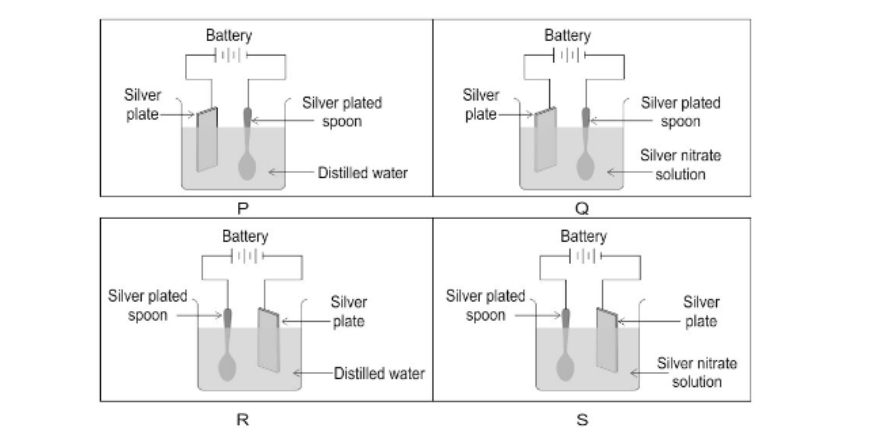
(a) P
(b) Q
(c) R
(d) S
(vii) The basicity of acetic acid is:
(a) 1
(b) 2
(c) 3
(d) 4
viii) A-> A+³; B-> B‐¹
Number of electrons present in the outermost shell of atoms A and B respectively are:
(a) 5, 1
(b) 3, 1
(c) 3, 7
(d) 5, 7
(ix) A __________ solution is observed after placing Magnesium metal in a solution of Copper sulphate for half an hour.
(a) Blue
(b) Colourless
(c) Reddish brown
(d) Dirty green
(x) An element with atomic no. __________ will form an acidic oxide.
(a) 3
(b) 17
(c) 11
(d) 13
(xi) Which of the following is NOT true with respect to nitric acid?
(a) It is a strong reducing agent
(b) It is a strong oxidizing agent
(c) It is unstable to heat
(d) It liberates sulphur dioxide gas when treated with potassium sulphite
(xii) __________ is the functional group in methanol.
(a) >C=O
(b) –OH
(c) –CHO
(d) –COOH
(xiii) The process of electrolysis is an example of:
(a) Oxidation reaction
(b) Reduction reaction
(c) Redox reaction
(d) Displacement reaction
(xiv) The catalyst used in Ostwald’s process is ___________.
(a) Finely divided iron
(b) Graphite
(c) Vanadium pentoxide
(d) Platinum
(xv) An element belongs to third period and sixteenth group. It will have __________ electrons in its valence shell.
(a) 2
(b) 5
(c) 6
(d) 3
Question 2
(i) The setup shown below is that of the fountain experiment with hydrogen chloride gas in the flask
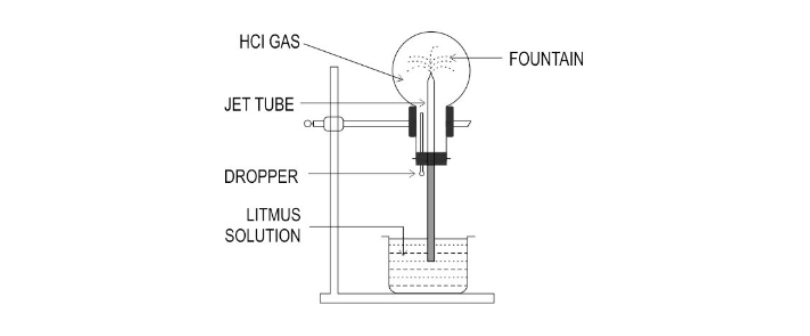
The fountain starts when a few drops of water from the dropper are introduced into the flask. Instead of the drops of water, Pooja started the fountain by introducing a few drops of Sodium hydroxide into the flask.
(a) Explain why the litmus solution gets sucked up when Sodium hydroxide is used.
(b) What will be the colour of the fountain when Sodium hydroxide is used?
Justify your answer.
(c) If instead of HCl gas, ammonia gas is filled in the flask and water is introduced from the dropper, will there be a different observation? Justify your answer.
(ii) Match the following Column A with Column B.

(iii) Complete the following by choosing the correct answers from the bracket:
(a) If an element has one electron in the outermost shell then it is likely to have the ___________ [smallest/ largest] atomic size amongst all the elements in the same period.
(b) ___________ [sulphuric acid/ hydrochloric acid] does not form an acid salt.
(c) A __________ [reddish brown/ dirty green] coloured precipitate is formed when ammonium hydroxide is added to a solution of ferric chloride.
(d) Alkanes undergo __________ [addition/ substitution] reactions.
(e) An __________ [alkaline/acidic] solution will turn methyl orange solution pink.
(iv) Identify the following:
(a) A bond formed between two atoms by sharing of a pair of electrons, with both electrons being provided by the same atom.
(b) A salt formed by the complete neutralization of an acid by a base.
(c) A reaction in which the hydrogen of an alkane is replaced by a halogen.
(d) The energy required to remove an electron from a neutral gaseous atom.
(e) A homogenous mixture of two or more metals or a metal and a non-metal in a definite proportion in their molten state. [5]
(v) (a) Draw the structural diagram for the following compounds:
1. 1- propanal
2. 1, 2 dichloro ethane
3. But-2-ene
(b) Give the IUPAC name of the following organic compounds:

Class 10 Chemistry Specimen Paper 2024
SECTION B
(Attempt any four questions.)
Question 3
(i) Identify the reactant and write the balanced equation for the following:
Nitric acid reacts with compound Q to give a salt Ca(NO3)2, water and carbon
dioxide.[2]
(ii) What property of Sulphuric acid is exhibited in each of the following cases:
(a) In the preparation of HCl gas when it reacts with Sodium chloride.
(b) When conc. Sulphuric acid reacts with Copper to produce Sulphur dioxide gas.
(iii) The electron affinity of an element X is greater than that of element Y.
(a) How is the oxidising power of X likely to compare with that of Y?
(b) How is the electronegativity of X likely to compare with that of Y?
(c) State whether X is likely to be placed to the left or to the right of Y in the periodic table?[3]
(iv) (a) State wether the following statements are TRUE or FALSE. Justify your answer.
1. In an electrovalent compound, the cation attains the electronic configuration of the noble gas that comes after it in the periodic table.
2. In the formation of a compound PQ2, atom P gives one electron to each atom of Q. The compound PQ2 is a good conductor of electricity.
(b) Calculate the number of moles in 22 grams of carbon dioxide .
Question 4
(i) The following questions relate to the extraction of Aluminium by electrolysis.
(a) Name the other aluminum containing compound added to alumina.
(b) Give a balanced equation for the reaction that takes place at the cathode. [2]
(ii) A gas cylinder of capacity 40 dm3 is filled with gas X the mass of which is 20 g. When the same cylinder is filled with hydrogen gas at the same temperature and pressure the mass of hydrogen is 2 g. Find the relative molecular mass of the gas. [2]
(iii) Give balanced equations for each of the following:
(a) Action of warm water on Aluminium nitride.
(b) Oxidation of carbon with conc. Nitric acid.
(c) Dehydration of ethanol by conc. Sulphuric acid at a temperature of 170oC
(iv) With respect to Haber’s process answer the following:
(a) Temperature of the reaction
(b) Catalyst used
(c) Balanced equation for the reaction occurring
Question 5
(i) (a) Ranjana wants to prove that ammonia is a reducing agent. To demonstrate this,
she passes ammonia gas over heated copper oxide. What will she observe?
(b) Write a balanced chemical equation for the above reaction.[2]
(ii) Name the alloy which is made up of:
(a) Copper, Zinc and Tin
(b) Lead and Tin[2]
(iii) Seema takes a blue crystalline salt P in a test tube. On heating it produces a white
anhydrous powder. P is dissolved in water. Zinc is added to one part of the solution
and to another part of the solution Barium chloride is added.
(a) Name the compound P.
(b) Mention one observation when zinc is added to the solution of P.
(c) State the colour of the precipitate formed when barium chloride is added to the
solution of P.
(iv) Give reasons:
(a) Ethene undergoes addition reaction.
(b) Hydrocarbons can be used as fuels.
(c) Hydrogen chloride gas cannot be collected over water.[3]
Question 6
(i) Name the following:
(a) The ore of Zinc containing its sulphide .
(b) The most commonly used oxide ore of Aluminium. [2]
(ii) State one observation in the following cases:
(a) Sodium chloride solution is added to a solution of lead nitrate.
(b) Barium chloride solution is added to a solution of Zinc sulphate.
(iii) Copper sulphate solution is electrolysed using copper electrodes.
(a) Which electrode [cathode or anode] is the oxidizing electrode? Why?
(b) Write the equation for the reaction occurring at the above electrode. [3]
(iv) X [2, 8, 7] and Y [2, 8, 2] are two elements. Using this information complete the
following:
(a) __________ is the metallic element.
(b) Metal atoms tend to have a maximum of __________ electrons in the
outermost shell.
(c) ___________ is the reducing agent.[3]
Question 7
(i) The empirical formula of an organic compound is C3H4N. Its molecular weight is 108. Find the amount of carbon in one mole of the compound. Show all the steps involved.
(Atomic weights: C- 12; H- 1; N- 14)[3]
(ii) (a) Mahesh prepared a basic solution X that has a pH 7.
How will the pH of the solution X change on addition of the following:
1. Hydrochloric acid
2. a solution of a base
(b) The atomic number of an element is 15. To which group will this element belong to? [3]
(iii) 8.2 grams of calcium nitrate is decomposed by heating according to the equation
2Ca (NO3)2 _____ 2CaO +4NO2 + O2
Calculate the following:
(a) Volume of nitrogen dioxide obtained at STP
(b) Mass of CaO formed
[Atomic weights: Ca –40 , N—14, O—16]
Question 8
(i) State giving reasons if:
(a) zinc and aluminium can be distinguished by heating the metal powder with concentrated sodium hydroxide solution.
(b) calcium nitrate and lead nitrate can be distinguished by adding ammonium
hydroxide solution to the salt solution.[2]
(ii) Draw the electron dot diagram of Hydronium ion. [2]
(iii) Give balanced equations for the following:
(a) Laboratory preparation of ethyne from calcium carbide.
(b) Conversion of acetic acid to ethyl acetate.
(c) Laboratory preparation of nitric acid.[3]
(iv) Identify the following substances:
(a) An alkaline gas which produces dense white fumes when reacted with HCl gas.
(b) The anion present in the salt, which produces a gas with the smell of rotten eggs when reacted with dil. HCl.
(c) The particles present in strong electrolytes.

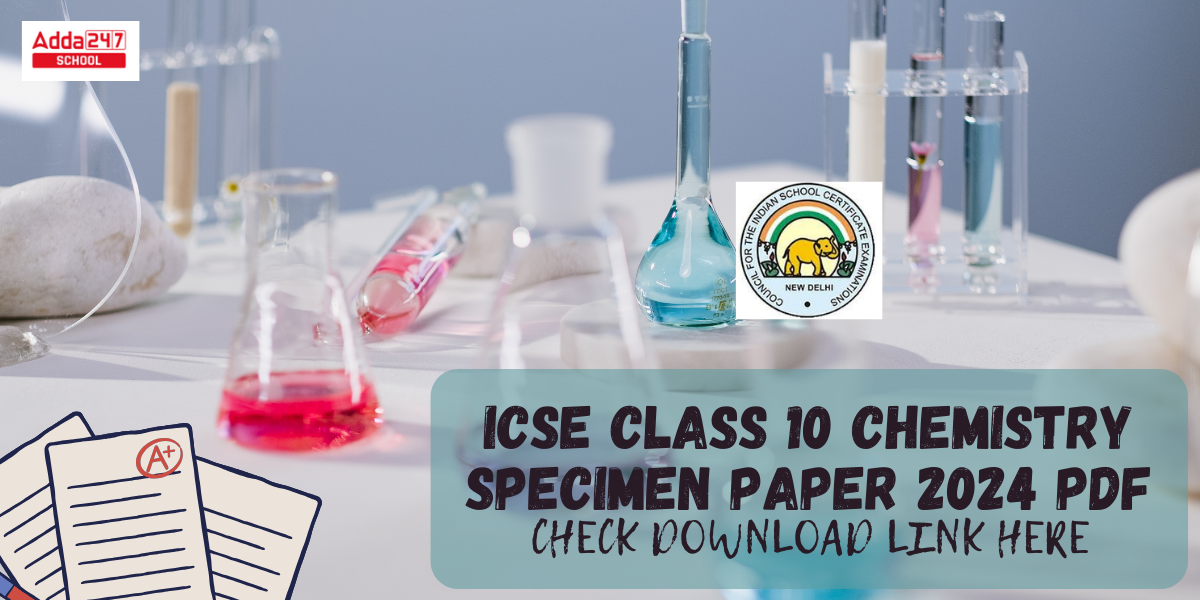







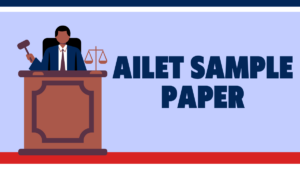 AILET Sample Paper 2026 Out, Download PD...
AILET Sample Paper 2026 Out, Download PD...
 CBSE Class 10 IT Sample Paper 2025-26 PD...
CBSE Class 10 IT Sample Paper 2025-26 PD...
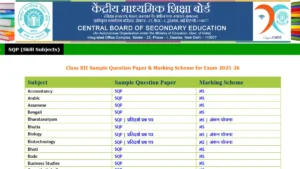 CBSE Class 12 Sample Paper 2026 with Sol...
CBSE Class 12 Sample Paper 2026 with Sol...














